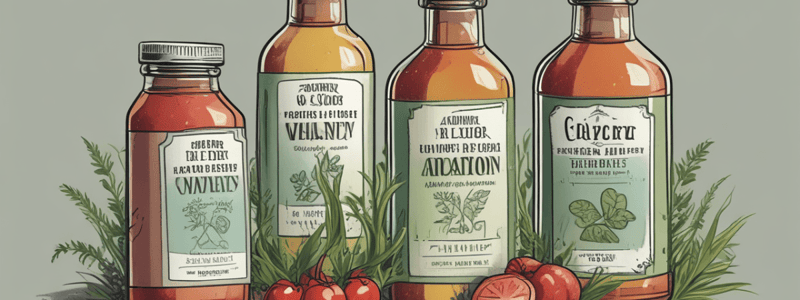Podcast
Questions and Answers
What do food additives with numbers ranging from 400 to 499 primarily function as?
What do food additives with numbers ranging from 400 to 499 primarily function as?
- Flavor enhancers
- Mineral salts, flour treatment agents, anti-caking agents, acidity regulators, color retention agents
- Thickeners, vegetable gums, emulsifiers, stabilizers, humectants (correct)
- Coloring Agents
What is the primary function of emulsifiers in food?
What is the primary function of emulsifiers in food?
- To preserve food
- To enhance flavor
- To mix or blend two or more liquids that wouldn't normally mix (correct)
- To add color
What classification of food additives includes glazing agents, bleaching agents, and artificial sweeteners?
What classification of food additives includes glazing agents, bleaching agents, and artificial sweeteners?
- 600-699
- 100-199
- 500-599
- 900-999 (correct)
What is the acceptable daily intake (ADI) of a food additive?
What is the acceptable daily intake (ADI) of a food additive?
What type of food additive is used to prevent spoilage and extend shelf life?
What type of food additive is used to prevent spoilage and extend shelf life?
What is the primary function of antioxidants in food?
What is the primary function of antioxidants in food?
What organization established the classification system for food additives?
What organization established the classification system for food additives?
What is the purpose of food additive regulations?
What is the purpose of food additive regulations?
What is the purpose of sweeteners as food additives?
What is the purpose of sweeteners as food additives?
What is the abbreviation for 'Generally Recognized As Safe'?
What is the abbreviation for 'Generally Recognized As Safe'?
What is the primary function of emulsifiers as food additives?
What is the primary function of emulsifiers as food additives?
What is the name of the committee responsible for regulating food additives at the international level?
What is the name of the committee responsible for regulating food additives at the international level?
What is the purpose of flavor enhancers as food additives?
What is the purpose of flavor enhancers as food additives?
What is the purpose of aromatic substances as food additives?
What is the purpose of aromatic substances as food additives?
What is the E-number system used for in the EU?
What is the E-number system used for in the EU?
What is the primary function of antioxidants as food additives?
What is the primary function of antioxidants as food additives?
What is the primary purpose of adding additives to food?
What is the primary purpose of adding additives to food?
What is the primary function of emulsifiers in food products?
What is the primary function of emulsifiers in food products?
What is the primary basis for classifying food additives?
What is the primary basis for classifying food additives?
What is the primary function of antioxidants in food products?
What is the primary function of antioxidants in food products?
What is the primary purpose of the ADI (Acceptable Daily Intake) in food additive regulations?
What is the primary purpose of the ADI (Acceptable Daily Intake) in food additive regulations?
Which of the following regulations is responsible for governing the use of food additives in the US?
Which of the following regulations is responsible for governing the use of food additives in the US?
What is the primary function of antioxidants in food?
What is the primary function of antioxidants in food?
What type of food additives are used to prevent deterioration caused by microorganisms?
What type of food additives are used to prevent deterioration caused by microorganisms?
What is the function of coloring agents in food?
What is the function of coloring agents in food?
What is the primary function of antioxidants as food additives?
What is the primary function of antioxidants as food additives?
What is the primary function of sweeteners as food additives?
What is the primary function of sweeteners as food additives?
What is the purpose of flavor enhancers as food additives?
What is the purpose of flavor enhancers as food additives?
Which of the following is an example of a natural antioxidant?
Which of the following is an example of a natural antioxidant?
What is the primary function of coloring agents as food additives?
What is the primary function of coloring agents as food additives?
What is the purpose of sweeteners as food additives?
What is the purpose of sweeteners as food additives?
What type of food additives are used to enhance the flavor of food?
What type of food additives are used to enhance the flavor of food?
What is the primary function of thickeners in food?
What is the primary function of thickeners in food?
Which of the following is an example of an artificial sweetener?
Which of the following is an example of an artificial sweetener?
What is the purpose of preservatives as food additives?
What is the purpose of preservatives as food additives?
Which of the following is an example of a synthetic antioxidant?
Which of the following is an example of a synthetic antioxidant?
What is the acronym for 'Generally Recognized As Safe'?
What is the acronym for 'Generally Recognized As Safe'?
What is the primary function of aromatic substances as food additives?
What is the primary function of aromatic substances as food additives?
What is the primary purpose of general recognition of safety through scientific procedures?
What is the primary purpose of general recognition of safety through scientific procedures?
Which of the following food additives are used to prevent spoilage and extend shelf life?
Which of the following food additives are used to prevent spoilage and extend shelf life?
What is the primary function of anticaking agents in food?
What is the primary function of anticaking agents in food?
What is the primary purpose of cryoprotectants in fish and fishery products?
What is the primary purpose of cryoprotectants in fish and fishery products?
What is the primary function of emulsifiers in sauces?
What is the primary function of emulsifiers in sauces?
What is the primary consideration in determining the functional need of a food additive?
What is the primary consideration in determining the functional need of a food additive?
Flashcards
Food Additives
Food Additives
Substances intentionally added to food for techno-functional purposes, not normally consumed alone.
GRAS (Generally Recognized As Safe)
GRAS (Generally Recognized As Safe)
Status indicating that a food additive is considered safe by experts, either through scientific procedures or common use before 1958.
E-Number System
E-Number System
A classification system for food additives in the EU, using codes to indicate different types of additives.
Flavor Enhancers
Flavor Enhancers
Signup and view all the flashcards
Sweeteners
Sweeteners
Signup and view all the flashcards
Aromatic Substances
Aromatic Substances
Signup and view all the flashcards
Acceptable Daily Intake (ADI)
Acceptable Daily Intake (ADI)
Signup and view all the flashcards
Coloring Agents
Coloring Agents
Signup and view all the flashcards
Emulsifiers
Emulsifiers
Signup and view all the flashcards
Thickeners
Thickeners
Signup and view all the flashcards
Anti-caking Agents
Anti-caking Agents
Signup and view all the flashcards
Antioxidants
Antioxidants
Signup and view all the flashcards
Conservatives
Conservatives
Signup and view all the flashcards
Study Notes
Food Additives
- Food additives are substances intentionally added to food for techno-functional purposes, not normally consumed by themselves.
- They are regulated by government bodies, but highly industry-driven.
GRAS (Generally Recognized As Safe)
- GRAS is a status for food additives that are considered safe through scientific procedures or common use in food before 1958.
- Under 21 CFR 170.30(b), general recognition of safety through scientific procedures requires the same quantity and quality of scientific evidence as is required to obtain approval of the substance as a food additive.
- GRAS is based on generally available and accepted scientific data, information, or methods, which may be corroborated by unpublished scientific data.
Classification of Food Additives
- In the EU, food additives are classified using the E-number system, with ranges for different types of additives:
- 100-199: Coloring agents
- 200-299: Mainly preservatives
- 300-399: Mainly antioxidants and food acids
- 400-499: Thickeners, vegetable gums, emulsifiers, stabilizers, humectants
- 500-599: Mineral salts, flour treatment agents, anti-caking agents, acidity regulators, color retention agents
- 600-699: Flavor enhancers
- 900-999: Glazing agents, bleaching agents, artificial sweeteners
Types of Food Additives
- Flavor enhancers: substances that enhance the taste and/or aroma of a food without giving its own flavor (e.g. Monosodium glutamate)
- Sweeteners: additives used to provide sweet taste or mimic flavors (e.g. natural: Xylitol, Isomalt; artificial: Saccharin, Sucralose, Aspartame)
- Aromatic substances: substances that provide a new aroma and/or correct the aroma of food and beverages (e.g. hops in beer)
Regulation of Food Additives
- Main bodies responsible for regulating additives are the Scientific Committee for Food (SCF) at the European level and the FAO/WHO Committee of experts on food additives (JECFA) at the international level.
- All food additives used in a product should appear on food labels.
- Acceptable Daily Intake (ADI) is an estimate of the amount of a food additive that can be ingested daily over a lifetime without appreciable health risk.
Food Additives
- Food additives are substances added to food for technological or functional purposes, not normally consumed by themselves.
- Main bodies responsible for regulating additives: Scientific Committee for Food (SCF) at the European level and the FAO/WHO Committee of experts on food additives (JECFA) at the international level.
Types of Additives
- Coloring agents: modify or stabilize the coloring characteristics of a food (e.g. carotene, chlorophyll, FDA-approved certifiable colors, Titanium dioxide (E171)).
- Flavor enhancers: enhance the taste and/or aroma of a food without giving its own flavor (e.g. Monosodium glutamate).
- Sweeteners: provide a sweet taste or mimic flavors (e.g. Natural: Xylitol-E967, isomalt-E953; Artificial: saccharin-E954, sucralose-E955, aspartame).
- Aromatic substances: provide a new aroma and/or correct the aroma of food and beverages (e.g. hops in beer).
Stabilizers of Physical Characteristics
- Emulsifiers: allow the maintenance or formation of a homogeneous mixture of two or more non-miscible phases (e.g. carrageenan, guar gum, lecithin E322).
- Thickeners: preserve the textures of foods (e.g. E-406 (agar-agar) for jam preservation).
- Anti-caking agents: prevent the formation of clumps or lumps that affect product homogeneity (e.g. Silicon Dioxide E551, magnesium trisilicate, stearates of Ca and Mg, flour, starch).
Inhibitors of Chemical and Biological Alterations
- Antioxidants: delay or prevent the rancidity of foods due to oxidation (e.g. Tocopherols (E-306), Ascorbic acid (E-300), BHA (E-320), BHT (E-321)).
- Conservatives: protect food against deterioration caused by unwanted microorganisms (e.g. used in bakery, pastries, dairy, beverages, or meat products).
GRAS (Generally Recognized As Safe)
- Definition: a substance that is intentionally added to food is a food additive, unless it is generally recognized as safe among qualified experts.
- Regulation: under sections 201(s) and 409 of the Federal Food, Drug, and Cosmetic Act (the Act).
Studying That Suits You
Use AI to generate personalized quizzes and flashcards to suit your learning preferences.




